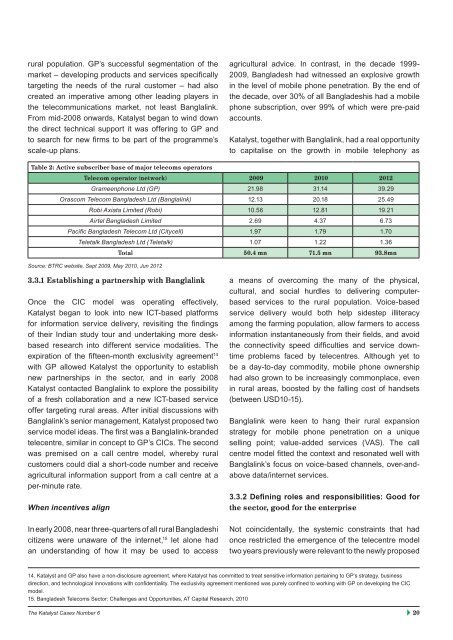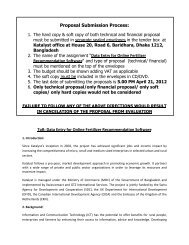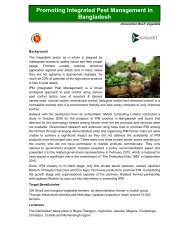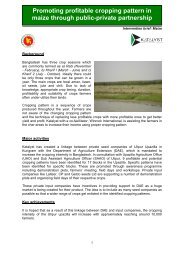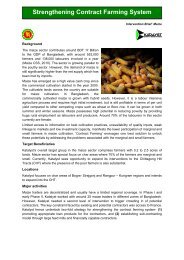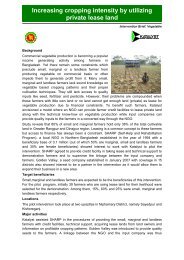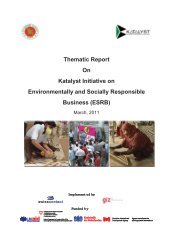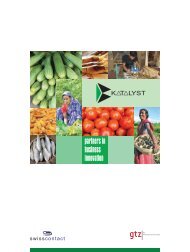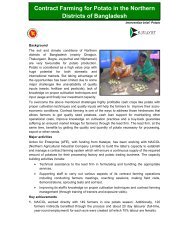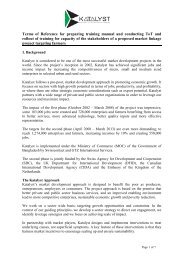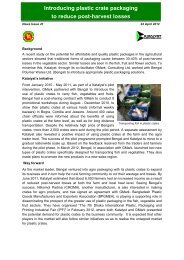Making ICT work for Bangladesh's farmers - Katalyst
Making ICT work for Bangladesh's farmers - Katalyst
Making ICT work for Bangladesh's farmers - Katalyst
You also want an ePaper? Increase the reach of your titles
YUMPU automatically turns print PDFs into web optimized ePapers that Google loves.
ural population. GP’s successful segmentation of the<br />
market – developing products and services specifically<br />
targeting the needs of the rural customer – had also<br />
created an imperative among other leading players in<br />
the telecommunications market, not least Banglalink.<br />
From mid-2008 onwards, <strong>Katalyst</strong> began to wind down<br />
the direct technical support it was offering to GP and<br />
to search <strong>for</strong> new firms to be part of the programme’s<br />
scale-up plans.<br />
agricultural advice. In contrast, in the decade 1999-<br />
2009, Bangladesh had witnessed an explosive growth<br />
in the level of mobile phone penetration. By the end of<br />
the decade, over 30% of all Bangladeshis had a mobile<br />
phone subscription, over 99% of which were pre-paid<br />
accounts.<br />
<strong>Katalyst</strong>, together with Banglalink, had a real opportunity<br />
to capitalise on the growth in mobile telephony as<br />
Table 2: Active subscriber base of major telecoms operators<br />
Telecom operator (net<strong>work</strong>) 2009 2010 2012<br />
Grameenphone Ltd (GP) 21.98 31.14 39.29<br />
Orascom Telecom Bangladesh Ltd (Banglalink) 12.13 20.18 25.49<br />
Robi Axiata Limited (Robi) 10.56 12.81 19.21<br />
Airtel Bangladesh Limited 2.69 4.37 6.73<br />
Pacific Bangladesh Telecom Ltd (Citycell) 1.97 1.79 1.70<br />
Teletalk Bangladesh Ltd (Teletalk) 1.07 1.22 1.36<br />
Total 50.4 mn 71.5 mn 93.8mn<br />
Source: BTRC website, Sept 2009, May 2010, Jun 2012<br />
3.3.1 Establishing a partnership with Banglalink<br />
Once the CIC model was operating effectively,<br />
<strong>Katalyst</strong> began to look into new <strong>ICT</strong>-based plat<strong>for</strong>ms<br />
<strong>for</strong> in<strong>for</strong>mation service delivery, revisiting the findings<br />
of their Indian study tour and undertaking more deskbased<br />
research into different service modalities. The<br />
expiration of the fifteen-month exclusivity agreement 14<br />
with GP allowed <strong>Katalyst</strong> the opportunity to establish<br />
new partnerships in the sector, and in early 2008<br />
<strong>Katalyst</strong> contacted Banglalink to explore the possibility<br />
of a fresh collaboration and a new <strong>ICT</strong>-based service<br />
offer targeting rural areas. After initial discussions with<br />
Banglalink’s senior management, <strong>Katalyst</strong> proposed two<br />
service model ideas. The first was a Banglalink-branded<br />
telecentre, similar in concept to GP’s CICs. The second<br />
was premised on a call centre model, whereby rural<br />
customers could dial a short-code number and receive<br />
agricultural in<strong>for</strong>mation support from a call centre at a<br />
per-minute rate.<br />
When incentives align<br />
In early 2008, near three-quarters of all rural Bangladeshi<br />
citizens were unaware of the internet, 15 let alone had<br />
an understanding of how it may be used to access<br />
a means of overcoming the many of the physical,<br />
cultural, and social hurdles to delivering computerbased<br />
services to the rural population. Voice-based<br />
service delivery would both help sidestep illiteracy<br />
among the farming population, allow <strong>farmers</strong> to access<br />
in<strong>for</strong>mation instantaneously from their fields, and avoid<br />
the connectivity speed difficulties and service downtime<br />
problems faced by telecentres. Although yet to<br />
be a day-to-day commodity, mobile phone ownership<br />
had also grown to be increasingly commonplace, even<br />
in rural areas, boosted by the falling cost of handsets<br />
(between USD10-15).<br />
Banglalink were keen to hang their rural expansion<br />
strategy <strong>for</strong> mobile phone penetration on a unique<br />
selling point; value-added services (VAS). The call<br />
centre model fitted the context and resonated well with<br />
Banglalink’s focus on voice-based channels, over-andabove<br />
data/internet services.<br />
3.3.2 Defining roles and responsibilities: Good <strong>for</strong><br />
the sector, good <strong>for</strong> the enterprise<br />
Not coincidentally, the systemic constraints that had<br />
once restricted the emergence of the telecentre model<br />
two years previously were relevant to the newly proposed<br />
14. <strong>Katalyst</strong> and GP also have a non-disclosure agreement, where <strong>Katalyst</strong> has committed to treat sensitive in<strong>for</strong>mation pertaining to GP’s strategy, business<br />
direction, and technological innovations with confidentiality. The exclusivity agreement mentioned was purely confined to <strong>work</strong>ing with GP on developing the CIC<br />
model.<br />
15. Bangladesh Telecoms Sector: Challenges and Opportunities, AT Capital Research, 2010<br />
The <strong>Katalyst</strong> Cases Number 6 20


